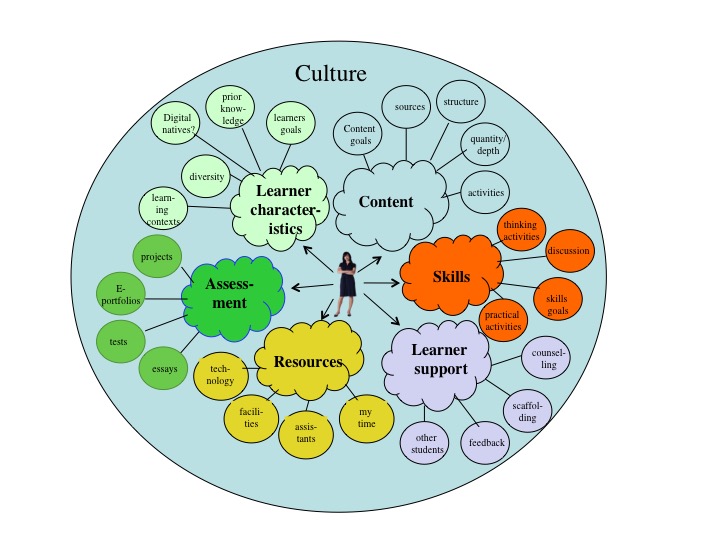Picture a drinking glass. It’s empty. Growing up, who fills your glass? Your parents, older siblings, teachers, camp instructors, etc. Let’s say this glass represents our capacity of knowledge. Our adolescent lives are spent with a select few filling the majority of our glass. When do we start to take over and decide what goes into our own glass? In the traditional educational system, there is a teacher based approach where the teacher is in charge of mostly filling the glass. The teacher presents a topic. The student mimics what is learned from the teacher and then applies it to an isolated task, thus the teacher is responsible for what goes in. The student is slowly but surely filling their glass. In the 21st century learning environments there is more of a learning based approach. Consider those approaches proposed by Sealy Brown and George Siemens. The responsibility of filling the glass shifts primarily to the learner and the resources readily available. As the learner starts filling their own glass, they are also filling the glasses of their peers and allowing those peers to add to back into the learner’s glass. The glass is being filled faster and in a variety of ways. How? They do this through collaboration and technology. Through shared interests, inquiry, niches, and learning communities. This process also allows others to help fill their own glasses through interactions with the learner. When a glass is full, they are not finished, or satisfied, rather ready for a bigger glass. This “what’s next?” approach is 21st century learning.

Learning Environments and Ecologies
How are learning environments built? What are the components of learning ecologies? There are many tenants or requirements for new learning environments. In an article, “Culture and Learning Environments”, by Anthony Bates, I came across 10 tenants that I believe stand out above the rest.
- Creating a culture that infuses the learning environment
- Clear and specific goals for teacher and learner
- Activities that best support learning
- Assessment strategies that will best measure and drive learning
- Respect between instructor and students, students and students
- Openness to differing views and opinions,
- Evidence based arguments and reasoning
- Fun and engaging learning
- Personalization and imagination
- Collaboration and mutual support.
Bates, A. (n.d.). Teaching in a Digital Age. Retrieved January 25, 2019, from https://opentextbc.ca/teachinginadigitalage/chapter/a-9-culture-and-learning-environments/.

So, how do we cultivate these tenants? Don’t these tenants exist in our learning theories? Yes, they do. But by adapting our current learning theories, instilling modern strategies, and recognizing the significant trends taking place in learning we can better understand this new generation of learners. Technology is “rewiring” our brains and changing the way we learn. Learning is occurring in a variety of ways. While traditional formal learning was king, informal learning is now becoming a huge part of our learning experience. As learners, it’s not about knowing how or knowing what, but rather knowing where to find information. As evidenced by Sealy Brown and Thomas learning is more than facts, figures, and data points. It’s about passion, interests and imagination.
Connectivism: Cultivation Through Collaboration
“The health of the learning ecology of the organization depends on effective nurturing of information flow.” Connectivism: A Learning Theory for the Digital Age, George Siemens.

Most of our learning theories were constructed when technology was non existent or at its infantile stage. This is not to say these theories are incorrect or wrong, or even ancient, but could they be updated to mesh more with the 21st century learner?
What I found to be the most damning quote of Siemens article was the following:
“The field of education has been slow to recognize both the impact of new learning tools and the environmental changes in what it means to learn. Connectivism provides insight into learning skills and tasks needed for learners to flourish in a digital era.“Connectivism: A Learning Theory for the Digital Age”, George Siemens
This really resonated with me as a 10 year teacher and education veteran. As educators, we always seem to be a few steps behind instead of getting out in front of these trends. These proposals of connectivism and cultivating new cultures of learning aren’t suggesting tearing down the old regime, but rather building upon, modifying, and amending.
Consider the constitution. I won’t get into politics, or what is right and wrong, but what I do know is it is a living document constructed hundreds of years ago when the world was a completely different place than today. Over those years, the document, which has remained true to its beginnings in spirt, has been amended to keep with the changes of our country and world. Will it continue to change and be amended? My guess is yes. It’s not just politics. The way we fight fires and crimes, to the way we transport goods and people across the world has also changed along with advancements of technology. So why wouldn’t education and learning?
If we think of these new learning environment and ecologies as pipelines it becomes easier to comprehend. “The pipe is more important than the content within the pipe. Our ability to learn what we need for tomorrow is more important than what we know today.” Connectivism: A Learning Theory for the Digital Age”, George Siemens
There are certainly challenges. The ease that information is accessed, assumed true, but not verified/fact checked, and then shared is very disturbing. What good is a pipeline if raw sewage is being dispersed? Children having to sift through misinformation, inappropriateness, could this lead to censorship? How as an instructor to I determine what is or isn’t appropriate for the learner?
When will schools provide the training and time required to prepare teachers to teach this new generation of learners? With teachers already facing deadlines and requirements for many other tasks, initiatives and responsibilities will they buy into these new models of instruction?
New Culture Of Learning
One thing is for sure. The landscape of education will be drastically changing over the next 5-10 years. Learning and knowledge rests in diversity of opinions ready to be produced and consumed by millions of learners. Consider this quote from Karen Stephenson, “Experience has long been considered the best teacher of knowledge. Since we cannot experience everything, other people’s experiences, and hence other people, become the surrogate for knowledge. ‘I store my knowledge in my friends’ is an axiom for collecting knowledge through collecting people (undated)”, Connectivism: A Learning Theory for the Digital Age, George Siemens. We fill our cups with experiences whether that be from our own or from others. Just like the cup. Our brains are not satisfied being filled. The capacity to know more is more critical than what is currently known.


Leave a Reply